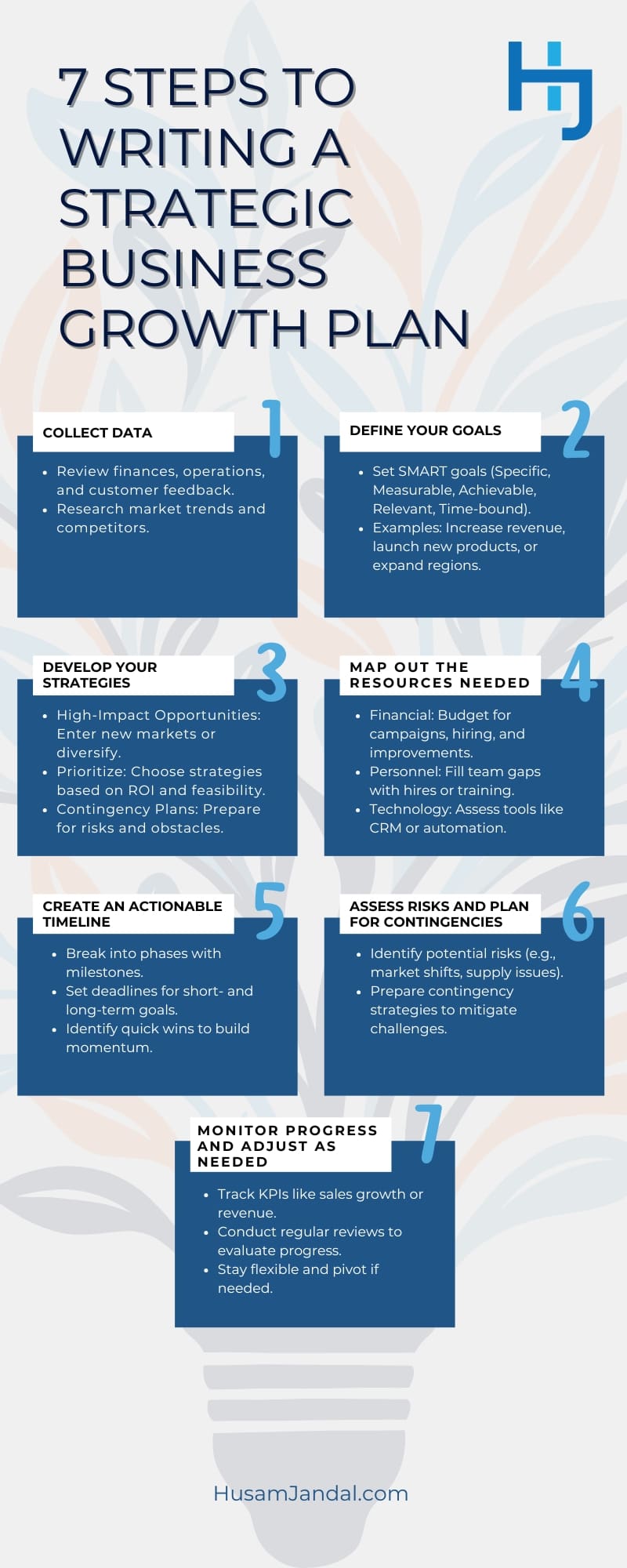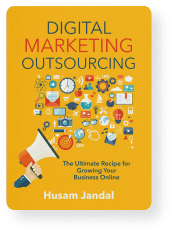 “If you build it, they will come.” While these words trace back to a box office hit from the last century, they’ve become quite the mantra in business. Simply put, if you create a great product or deliver the best service, your company is guaranteed to attract an audience and grow. The reality, however, is much different. Few businesses manage to take off this way, and those that do often wind up with a whole new set of challenges that determine their fate. The key, then, is not simply to build and hope for the best, nor is it to hope for extreme growth. If your goal is long-term success, you need to take a strategic approach. Below, I’ll walk you through strategic growth planning for businesses: why it’s vital, how to approach it, and how to develop a customized strategic growth plan that works for your business.
“If you build it, they will come.” While these words trace back to a box office hit from the last century, they’ve become quite the mantra in business. Simply put, if you create a great product or deliver the best service, your company is guaranteed to attract an audience and grow. The reality, however, is much different. Few businesses manage to take off this way, and those that do often wind up with a whole new set of challenges that determine their fate. The key, then, is not simply to build and hope for the best, nor is it to hope for extreme growth. If your goal is long-term success, you need to take a strategic approach. Below, I’ll walk you through strategic growth planning for businesses: why it’s vital, how to approach it, and how to develop a customized strategic growth plan that works for your business.
A Deeper Look at Business Growth
Before we get into strategic growth planning for businesses, let’s take a closer look at what growth really means.
Stages of Business Growth
The stages of business growth often follow a predictable lifecycle, though the specifics can vary depending on the industry, size, and type of business. Here’s a brief outline of the commonly recognized stages.
Seed Stage
The seed stage is all about turning an idea into a viable business concept. At this stage, the focus is on defining the business model, conducting market research, and creating a solid business plan. Entrepreneurs often work on building initial resources and securing funding to get their ideas off the ground. Common challenges include validating the business idea, finding investors, and setting the foundation for future growth.
Startup Stage
During the startup stage, the business transitions from planning to execution. This is when operations are set up, the first products or services are launched, and initial customers are acquired. Testing market fit and refining offerings based on feedback are critical at this point. Challenges often include managing cash flow, addressing operational inefficiencies, and building brand awareness in a competitive landscape.
Growth Stage
The growth stage is characterized by scaling and expansion. Businesses focus on increasing sales, optimizing processes, and entering new markets. This is also the stage where systems and infrastructure need to scale to handle growing demand. While exciting, rapid growth can bring challenges like maintaining quality, managing resources effectively, and ensuring customer satisfaction as operations expand. For businesses looking to scale strategically while maintaining efficiency, working with a fractional CMO can be an effective way to develop and execute a structured growth plan.
Maturity Stage
At the maturity stage, the business has achieved stability and a strong market presence. The focus shifts to optimizing operations, maximizing profits, and retaining market share. However, maturity can bring its own challenges, such as market saturation, increased competition, and the need to continuously innovate to stay relevant. Companies often refine their offerings and prioritize customer retention strategies during this phase.
Renewal or Decline Stage
In the renewal or decline stage, businesses must choose between revitalizing their operations or managing a decline. Renewal often involves innovation, diversification, or repositioning in the market to reignite growth. Decline, on the other hand, might require cutting costs, liquidating assets, or pivoting to entirely new opportunities. This stage is defined by tough decisions, managing stakeholder expectations, and executing significant changes to ensure the business’s long-term viability.
Why Planning Your Business Growth is Essential
While growth can sometimes happen unexpectedly, it isn’t always sustainable or manageable without a plan in place. Rapid, unplanned growth can overwhelm resources, strain operations, and lead to missed opportunities. That’s why strategic growth planning is so important. It helps you harness and sustain growth effectively. Here’s how.
You Gain Clear Direction
Even if growth begins organically, a well-thought-out plan ensures you stay on track toward long-term goals. It helps prioritize actions that align with your vision and prevent the business from veering off course.
Unmanageable Growth is Put in Check
Rapid growth seems like a dream until it actually happens to your business. It places an unimaginable strain on your team, systems, and cash flow. If you’re unprepared for this, the outcome can be catastrophic. In fact, a secondary review of Inc. Magazine’s 5,000 fastest-growing companies shows that five to eight years after making the list, two-thirds have shrunk, sold for less than they were worth, or outright closed, as Yahoo! reports. Planning equips you with the tools to scale operations, maintain quality, and manage the complexities that come with expansion.
Resource Allocation Can Be Optimized
A growth plan helps you allocate resources efficiently, avoiding the pitfalls of overextending in some areas while neglecting others. It ensures your investments deliver maximum impact.
Your Competitive Edge is Strengthened
Planning allows you to adapt quickly to unexpected growth while staying ahead of competitors. You can seize opportunities strategically rather than reacting impulsively to changes in demand.
It Builds Stakeholder Confidence
Whether growth is intentional or accidental, a solid plan demonstrates to stakeholders that you have control over your trajectory. It reassures investors, partners, and your team that you’re prepared for challenges.
Types of Business Growth
Business growth can take various forms depending on your goals, resources, and market opportunities. Here’s a breakdown of the main types of growth to consider.
Organic Growth
Organic growth occurs naturally when your business increases revenue through internal efforts like improving products, expanding your customer base, or enhancing marketing strategies. It’s often slower but more sustainable since it relies on existing resources rather than external funding or partnerships.
Strategic Growth
Strategic growth focuses on long-term planning and deliberate actions to achieve specific goals, such as entering new markets or launching new product lines. It often requires significant research, investment, and alignment with your overall business strategy. Digital marketing for financial services, for example, can play a critical role in supporting strategic growth by helping financial businesses reach their ideal audience while navigating industry regulations.
Internal Growth
Internal growth involves scaling operations from within by optimizing processes, developing talent, or upgrading infrastructure. It’s about strengthening your business’s core to handle increased demand or improve efficiency.
Growth Through Mergers, Partnerships, or Acquisitions
This type of growth occurs when businesses combine forces with others, whether through partnerships, mergers, or outright acquisitions. It’s often faster than organic growth but can be complex, requiring careful planning and integration.
Areas of Focus for Business Growth

When planning for growth, it’s important to identify the key areas that will drive your business forward. Here are some critical areas to consider:
- Team Size: Scaling often requires hiring more employees or upskilling your current team to handle increased workloads and maintain quality.
- Physical Space: As your business grows, you might outgrow your current office, warehouse, or retail location. Expanding or optimizing physical space can support efficiency and accommodate more customers or inventory.
- Additional Locations: Opening new branches or facilities can help you serve more customers, increase brand visibility, and tap into untapped markets.
- New Regions: Expanding into new geographic markets, be it locally, nationally, or internationally, can diversify your customer base and reduce reliance on one area.
- New Products: Innovating or expanding your product or service lineup can attract new customers, meet evolving market demands, and increase revenue streams.
- Technology and Systems: Investing in tools like CRM software, automation, or upgraded infrastructure ensures you can manage growth effectively without sacrificing efficiency.
- Brand and Marketing: Strengthening your brand and scaling marketing efforts ensures your growth initiatives reach the right audience and maintain momentum.
- Customer Experience: Enhancing support channels, reducing wait times, or offering personalized services can help retain customers as your business scales.
The Basics of Strategic Growth Planning for Businesses
Now that we’ve covered what business growth looks like and the many forms it can take, let’s dig into the planning phase.
What is a Business Growth Plan?
A business growth plan is a detailed roadmap that outlines how your business intends to expand over time. It identifies goals, strategies, and the resources needed to achieve them, focusing on areas like increasing revenue, expanding market share, or launching new products.
Business Growth Strategies vs. Business Growth Plans
While the terms are often used interchangeably, they serve different purposes:
- Business Growth Strategies: These are high-level approaches or methods used to achieve growth. Examples include market penetration, diversification, or product development. Think of them as the blueprints for growth.
- Business Growth Plans: These are the execution guides that turn strategies into actionable steps. They detail how, when, and where specific growth strategies will be implemented.
For example, if your strategy is to expand into new markets, the growth plan will outline the steps, such as market research, hiring local staff, or creating a marketing campaign tailored to the new audience.
Business Growth Plan vs. Business Plan
A business plan is a broader document that encompasses all aspects of your business, including your mission, vision, target market, operations, and financial projections. It’s often used to secure funding or communicate the overall direction of the business.
A business growth plan, on the other hand, is more focused. It dives deeply into how your business will expand in specific areas, like increasing customer acquisition, improving profitability, or scaling operations. In short:
- Business Plan: Big-picture focus, suitable for starting a business or pitching to investors.
- Growth Plan: Narrow focus, aimed at scaling specific areas of an already operating business.
Growth Plan vs. Strategic Growth Plan
While they are closely related, the growth plan and strategic growth plan have distinct roles.
- Growth Plan: Focuses on the how. It’s action-oriented, detailing specific tasks and resources needed for short-term goals, such as launching a new product or increasing sales in the next quarter.
- Strategic Growth Plan: Focuses on the why and what. It’s broader and long-term, aligning growth initiatives with the company’s mission, vision, and overall strategy. It provides the big-picture framework within which growth plans operate.
Think of a strategic growth plan as setting the direction. For instance, “We aim to become the market leader in renewable energy within five years.” The growth plan, then, is the steps to get there, such as “Launch three new solar products in the next 12 months and hire 10 sales reps to expand into regional markets.”
Who Needs a Strategic Business Growth Plan?
A strategic business growth plan isn’t just for large corporations. It’s essential for businesses of all sizes and stages looking to scale intentionally and sustainably. Here’s who benefits most.
Small Businesses Preparing to Scale
Small businesses aiming to grow beyond their current capacity need a clear plan to avoid overextending resources or losing focus. Whether it’s hiring staff, entering new markets, or launching products, a strategic growth plan ensures every step aligns with long-term goals.
Established Companies Seeking Market Expansion
Businesses looking to expand into new regions or introduce new offerings can use a strategic growth plan to research opportunities, analyze competitors, and allocate resources effectively.
Startups Navigating Rapid Growth
For startups experiencing fast growth, a plan helps manage scaling challenges like cash flow, staffing, and operational inefficiencies while maintaining quality and customer satisfaction.
Businesses Facing Market Disruptions
Companies in industries undergoing significant changes like technology or healthcare can use a strategic growth plan to stay competitive by adapting quickly to new trends or customer demands.
Companies Preparing for Investment or Partnerships
A strategic growth plan demonstrates to investors, lenders, or partners that your business is growth-ready, increasing confidence and improving your chances of securing funding or collaboration.
When Should I Develop a Strategic Business Growth Plan?
The right time to develop a strategic business growth plan often depends on your business’s current situation and goals. Here are the key scenarios when creating or revisiting a growth plan is essential.
At the Start of a Growth Phase
If you’re about to scale your business, whether it’s launching a new product, expanding into new markets, or increasing production capacity, a growth plan ensures you have a clear roadmap to guide your efforts.
When Experiencing Rapid Growth
Unexpected or accelerated growth can strain your resources, systems, and team. A growth plan helps you manage this momentum effectively, maintaining quality and avoiding burnout or inefficiencies.
Before Seeking Funding or Partnerships
Investors and partners want to see a solid plan that outlines your growth strategy, goals, and projections. A well-prepared plan demonstrates professionalism and increases your chances of securing support.
When Facing Market Changes or New Opportunities
If your industry is evolving, or you’ve identified a new opportunity, it’s the perfect time to revisit or create a growth plan. It will help you adapt to changes or capitalize on emerging trends while minimizing risks.
During Strategic Planning Cycles
Many businesses incorporate growth planning into their annual or quarterly strategic reviews. This ensures the plan stays aligned with changing goals, market conditions, and business performance.
When Growth Has Stalled
If your business has plateaued, developing a growth plan can help identify areas for improvement or untapped opportunities to reignite momentum.
Key Elements of a Strategic Business Growth Plan

A successful strategic business growth plan includes several essential components that work together to create a clear, actionable roadmap for achieving sustainable growth. Let’s break down these elements.
Executive Summary
This is a concise overview of your growth plan, designed to provide a high-level summary for stakeholders. It outlines your business’s current state, growth goals, and the key strategies you’ll use to achieve them. Think of it as the elevator pitch for your growth plan.
Customer Analysis
Understanding your customers is critical to growth. This section includes:
- Demographics: Who are your customers? (age, gender, location, etc.)
- Behavior: What are their purchasing habits, preferences, and pain points?
- Segmentation: How can you group customers to tailor strategies effectively?
- Needs Analysis: What specific problems does your business solve for them?
Market Analysis and Competitor Analysis
To grow, you need a thorough understanding of your market and competitors. Include:
- Market Trends: What’s happening in your industry? Are there opportunities or threats?
- Competitor Analysis: Who are your competitors, and what are their strengths, weaknesses, and strategies?
- Market Position: Where does your business stand, and where do you want to go?
Growth Objectives
Clearly define your growth goals using SMART criteria (Specific, Measurable, Achievable, Relevant, Time-bound). Examples might include increasing revenue by 25 percent in the next year or expanding into three new geographic regions.
Strategies and Processes
Detail the actions you’ll take to achieve your objectives. These might include:
- Expanding Product Lines: Introduce new products or services to attract more customers and meet diverse needs within your target market.
- Entering New Markets: Explore untapped geographic regions or customer segments to increase your market share and revenue potential.
- Enhancing Customer Retention: Implement loyalty programs or personalized experiences to build stronger relationships and encourage repeat business.
- Streamlining Operations: Optimize workflows and processes to improve efficiency, reduce costs, and handle growth more effectively.
Resources Needed
Growth requires resources. Outline what you’ll need to execute your plan, including:
- Financial Resources: Allocate budgets for key areas like marketing campaigns, hiring new team members, and research and development to support growth initiatives.
- Personnel: Hire new talent, train existing staff, or bring in external consultants to ensure your team has the skills and capacity to execute the growth plan.
- Technology and Tools: Invest in CRM systems, software upgrades, or new equipment to enhance efficiency and support scalability.
Final Projections
This section presents your growth forecasts. Include:
- Revenue Projections: Estimate future income based on planned growth initiatives and market conditions.
- Customer Acquisition Targets: Set specific goals for the number of new customers to gain within a defined timeframe.
- Cost Estimates: Outline the expected expenses required to execute the growth plan, including marketing, staffing, and operational costs.
- ROI Expectations: Define the anticipated return on investment for each growth initiative to measure its overall success and profitability.
Risk Factors
Growth always comes with risks. Identify potential challenges and how you’ll mitigate them:
- Internal Risks: Operational inefficiencies, staffing shortages, or budget constraints.
- External Risks: Economic downturns, regulatory changes, or competitive threats.
- Contingency Plans: Strategies for addressing risks if they arise.
Time
Timing is critical for growth initiatives. Include:
- Timeline for Each Phase: Establish a clear schedule outlining when different stages of the growth plan will be implemented.
- Milestones: Identify key progress points to track and measure success throughout the execution of the plan.
- Deadlines: Set specific deadlines for achieving objectives to ensure accountability and maintain momentum.
KPIs and Metrics for Success
Include key performance indicators (KPIs) that will help you measure progress. Examples might include:
- Customer Acquisition Costs (CAC): Track the expenses associated with gaining new customers to ensure efficient use of marketing and sales budgets.
- Lifetime Value of Customers (LTV): Measure the total revenue a customer generates over their relationship with your business to assess long-term profitability.
- Sales Growth Percentages: Monitor the rate at which sales are increasing over time to evaluate the effectiveness of growth strategies.
- Employee Productivity Metrics: Analyze team performance to ensure that growth efforts are supported by efficient and effective operations.
Organizational Alignment
Ensure your entire team understands and supports the growth plan. This section might include:
- Communication Strategies: Develop clear methods for aligning the team, such as regular updates, meetings, or collaborative tools, to ensure everyone is on the same page.
- Defined Roles and Responsibilities: Assign specific tasks and ownership for each growth initiative to create accountability and streamline execution.
- Growth-Focused Company Culture: Implement strategies that encourage innovation, collaboration, and a shared commitment to achieving growth goals.
How to Write a Strategic Business Growth Plan

Creating a strategic growth plan requires a methodical approach to ensure it’s actionable, realistic, and aligned with your goals. Below are the steps to develop a comprehensive plan.
Step 1: Collect Data
Before you can plan for growth, you need to understand your starting point. This step involves gathering key data about your business, customers, competitors, and market.
- Internal Data: Analyze financial performance, operational efficiency, customer feedback, and employee productivity metrics. Identify strengths and weaknesses in your current operations.
- Customer Insights: Use surveys, interviews, and analytics to understand customer needs, preferences, and pain points.
- Market Research: Investigate trends, opportunities, and threats in your industry. Evaluate market size, growth potential, and emerging technologies.
- Competitor Analysis: Assess competitors’ strengths, weaknesses, strategies, and market positions to identify gaps or opportunities you can leverage.
Step 2: Define Your Goals
Set clear, measurable growth objectives that align with your business vision. Use the SMART framework (Specific, Measurable, Achievable, Relevant, Time-bound) to ensure your goals are actionable. Examples include increasing revenue by 20 percent in the next year, launching a new product line, or expanding into three new regions.
Step 3: Develop Your Strategies
Based on your goals, outline the strategies you’ll use to achieve them. These should align with your market research and internal capabilities.
- Identify High-Impact Opportunities: Focus on initiatives such as entering new markets or diversifying product offerings to maximize growth potential.
- Prioritize Strategies: Evaluate options based on feasibility, return on investment (ROI), and how well they align with your long-term vision.
- Include Contingency Strategies: Prepare backup plans to address potential risks or obstacles that could derail your growth efforts.
Step 4: Map Out the Resources Needed
Determine what resources are required to execute your strategies effectively.
- Financial Resources: Budget for marketing campaigns, hiring, R&D, and operational improvements.
- Personnel: Identify gaps in your team and plan for hiring or training.
- Technology: Assess whether tools like CRM systems, automation, or new software are needed to support your goals.
Step 5: Create an Actionable Timeline
Work out a realistic timeline, considering all the steps that need to occur.
- Break the Plan into Phases: Divide your growth plan into clear stages, each with specific timelines and milestones to track progress.
- Set Deadlines for Objectives: Establish timeframes for both short-term and long-term goals to maintain focus and accountability.
- Identify Quick Wins: Highlight achievable goals early on to build momentum and boost confidence among stakeholders.
- Allow for Flexibility: Design your timeline to adapt as needed, ensuring it accommodates real-world changes and unforeseen challenges.
Step 6: Assess Risks and Plan for Contingencies
Growth comes with uncertainties. Identify potential risks, such as market volatility, supply chain disruptions, or financial constraints, and outline strategies to mitigate them. Contingency plans help you stay resilient if things don’t go as expected.
Step 7: Monitor Progress and Adjust as Needed
A growth plan isn’t static. It needs regular monitoring and adjustments.
- Monitor Key Performance Indicators (KPIs): Use metrics like customer acquisition costs, sales growth, or revenue milestones to track progress effectively.
- Schedule Regular Reviews: Conduct periodic evaluations to assess what’s working and identify areas that need adjustment.
- Prepare to Pivot: Stay flexible and ready to adjust strategies if market conditions or internal dynamics shift unexpectedly.
Additional Tips for Creating a Company Growth Strategy
Even the best growth plans can benefit from a few extra strategies to enhance their effectiveness. These additional tips will help you maximize your growth potential while staying adaptable and customer-focused.
- Leverage Technology and Automation: Use tools like CRM systems, analytics platforms, and automation software to streamline processes and gain insights that drive growth decisions.
- Stay Agile: Markets evolve, and customer needs shift. Build flexibility into your strategy so you can adapt quickly to changes without losing focus on long-term goals.
- Focus on Customer Retention: Growth isn’t just about acquiring new customers. It’s also about keeping the ones you have. Invest in loyalty programs, excellent customer service, and personalized experiences.
- Collaborate and Network: Partnering with complementary businesses or joining industry networks can open up new opportunities for growth, from joint ventures to shared resources.
- Build a Strong Brand: A recognizable, trusted brand is key to sustaining growth. Ensure consistency in messaging, values, and customer experience across all channels.
- Track and Celebrate Small Wins: Growth takes time, and celebrating milestones keeps your team motivated and invested in the process.
Fuse Your Strategic Planning with Digital Marketing
Oftentimes, businesses engage my services as a digital marketing consultant when they feel ready for growth but don’t necessarily have a detailed strategic growth plan developed. Whereas a digital marketing agency or traditional marketing professional may be happy to begin rolling out some marketing strategies, I feel that doing so would be a disservice to the businesses I serve. After all, when the marketing efforts begin producing results, the business may not be able to handle the new clients or may begin to see other areas of the business falter because they were unprepared for growth. That’s why I fuse strategic growth planning into my digital marketing strategies. It helps ensure the businesses achieve lasting growth rather than a temporary surge in sales. If you’re ready to scale in a holistic way, let’s talk. Contact me for a complimentary consultation.
FAQs on Strategic Growth Planning for Businesses
How do you measure the success of a growth plan?
Success is measured using Key Performance Indicators (KPIs) like revenue growth, customer acquisition, and profitability. Track metrics like customer retention rates, sales growth, and ROI for specific initiatives. Regularly review performance against your objectives and adjust as needed for sustained progress.
What tools or software can help with business growth planning?
Tools like CRM systems (Salesforce, HubSpot, Zoho CRM, etc.), project management platforms (Wrike, Asana, etc.), and analytics software (Google Analytics, Matomo, etc.) help manage growth. Financial tools like QuickBooks or budgeting apps also streamline resource allocation and forecasting. Choose tools that fit your specific needs and scale with your business.
How can small businesses compete with larger companies in terms of growth?
Small businesses can compete by focusing on agility, customer relationships, and niche markets. They should leverage digital marketing, provide personalized services, and innovate quickly to adapt to market changes. Staying lean and targeting underserved audiences also gives small businesses an edge over large companies.
What’s the difference between scaling and growing a business?
Growth refers to increasing revenue or market presence, often requiring proportional increases in resources like staff or capital. Scaling focuses on increasing revenue while minimizing added costs. For example, automating processes is a scaling tactic, while hiring more employees is growth-focused.
How does digital marketing support business growth strategies?
Digital marketing expands your reach, drives customer engagement, and increases brand visibility. Strategies like SEO, PPC campaigns, and social media marketing target specific audiences cost-effectively. Data-driven insights help refine efforts, ensuring higher ROI and supporting scalable growth.
What industries benefit most from a strategic growth plan?
Every industry can benefit, but sectors with rapid change, like technology, healthcare, and e-commerce, particularly thrive with strategic growth plans. Established industries, like manufacturing or retail, also use these plans to adapt to evolving customer needs and competitive pressures.
How can businesses ensure sustainable growth without overextending resources?
Focus on efficiency by streamlining operations and using scalable technologies. Prioritize customer retention and choose growth initiatives with high ROI. Regularly assess financial health and avoid over-committing resources. Sustainable growth requires balancing ambition with operational capacity.
When should a business consider hiring a growth consultant?
Hire a growth consultant if your business struggles to scale, faces market challenges, or lacks the expertise to plan effectively. Consultants bring fresh perspectives, identify opportunities, and create tailored strategies, making them valuable when tackling complex growth goals.
What role does innovation play in business growth planning?
Innovation drives growth by solving customer problems, improving efficiency, and creating competitive advantages. Whether launching new products, adopting emerging technologies, or rethinking business models, innovation keeps your business relevant and positions it for long-term success.





































































